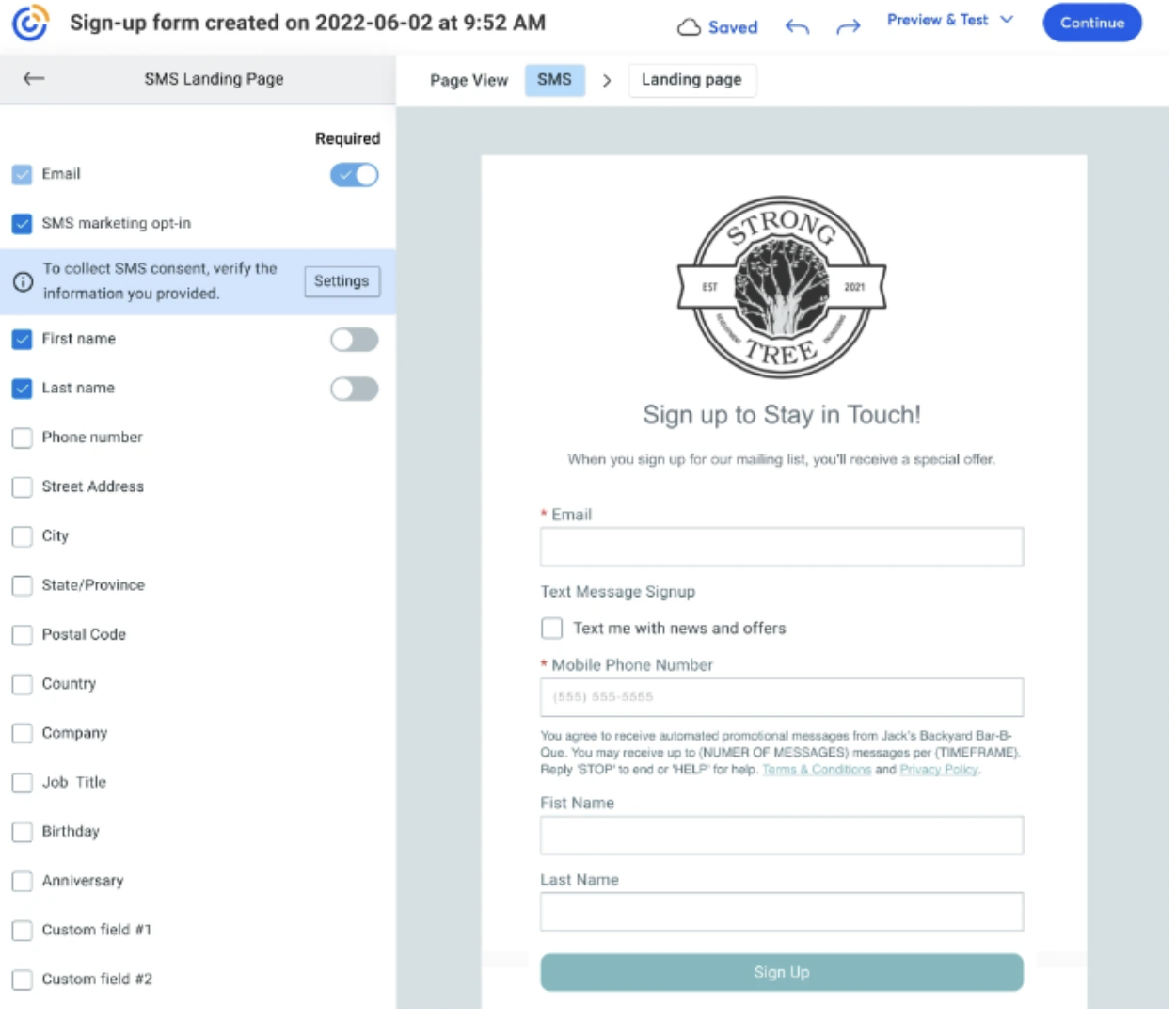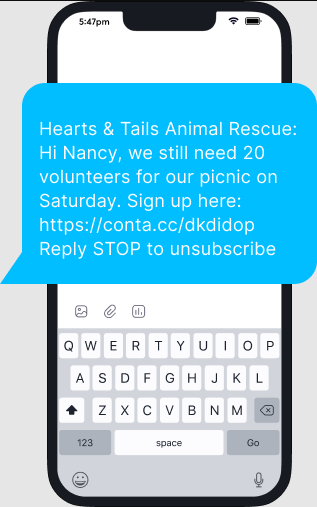
If you find yourself checking your phone often, you’re not alone.
In today’s digital landscape, mobile devices have become an integral part of our lives. No wonder many decision-makers and professionals rely heavily on their smartphones for work-related tasks. And as a B2B company, there’s a way to reach your target audience where they are most active and engaged — short message service (SMS) sales, a mobile-first communication strategy.
Text messages offer a more personal and direct way to communicate with B2B clients. Plus, you can tailor your SMS text message marketing for sales based on the recipient’s preferences, previous interactions, or specific needs. Here’s how to get started.
SMS sales defined
SMS sales is a mobile commerce strategy where you send text messages with offers, promotions, and reminders to a subscriber’s mobile device. It is also referred to as text marketing or mobile marketing.
To send sales SMS to customers, they must first provide you with their phone numbers and opt-in to receive your messages.
SMS marketing examples
As a B2B company, you can leverage SMS best practices to enhance customer engagement, promote events, and improve the overall customer experience in their business interactions.
Here are three examples of B2B SMS marketing ideas in action.
Appointment reminders
Imagine you are a software-as-a-service (SaaS) company that provides project management solutions. A lead has booked a demo, and you want to make sure they don’t miss the scheduled event. You can use SMS marketing to send appointment reminders to this client. To do this, you send an automated SMS a day or a few hours before the scheduled product demo or consultation.
The message can read like this. “Hi [Client’s Name], this is a friendly reminder that you have a product demo scheduled with us tomorrow at [Time]. We look forward to showcasing our project management solutions and addressing any questions you may have. See you soon!”
Event promotions
Your friend is a professional conference or trade show organizer. They can also leverage SMS marketing to promote their upcoming events to businesses and industry professionals.
If they have an SMS subscriber list of interested attendees, they can periodically send targeted SMS messages about event updates, speaker announcements, early-bird registration deadlines, and exclusive discounts.
Here’s how one of those messages could read. “Hey [Subscriber’s Name], the annual Tech Summit is just around the corner! Don’t miss out on the latest industry insights, keynote speeches, and networking opportunities. Register now using the code TECHSUMMIT20 for a 20% discount. Visit our website for more details. See you there!”
Order updates and tracking
One last example: Say you’re an ecommerce wholesaler that sells office supplies to other businesses. You can also utilize SMS text message marketing to provide order updates and tracking information.
After a customer places an order, your company can send automated SMS notifications at various stages of the order process, such as order confirmation, shipping confirmation, and delivery tracking details.
For example, “Great news, [Customer’s Name]! Your office supply order has been confirmed and is being prepared for shipment. You’ll receive another message with tracking details once it’s dispatched. Thanks for choosing us as your supplier!”
If it sounds easy, well, it is.
Why sell to B2B clients through SMS text messages?
More than half the world’s population owns a phone. So as a B2B company, it’s a good bet that your target clients are part of this statistic.
This audience is also most likely on social media or has an email address. That’s why some brands blend text message with email marketing. But there are instances where SMS marketing campaigns offer a higher chance of converting more B2B clients.
Higher open rates
98% of people open every text message they receive, with a staggering 95% doing so within the first three minutes. And it doesn’t matter if the message came from an unknown number; most people keep their mobile devices within reach and tend to check their messages promptly.
Plus, SMS messaging is not extensively utilized for business promotions. Typically, brands want to stay clear of overwhelming their subscribers with too many advertisements. So, when a customer receives an SMS from a familiar brand, they know it’s about something important and worth opening.
Increased conversions
On average, the click-through rate (CTR) or response rate of text messages is 33%, and 47% of marketing SMS recipients end up making a purchase. The clear and focused nature of SMS messages increases the likelihood of recipients understanding the offer or call to action, leading to higher response rates.
What’s more, text messages are typically delivered instantly, making them suitable for time-sensitive offers or urgent messages. The immediacy of SMS marketing allows businesses to reach customers when they are most likely to take action, leading to higher conversion rates.
A more personal feel
SMS marketing relies on recipients opting in to receive messages. This opt-in approach means that subscribers are already familiar with your brand.
When a recipient receives an SMS marketing message, they recognize the sender as someone they have already chosen to engage with, creating a sense of personal connection. Research shows that personalization can increase revenue by up to 40%.
How to use an SMS sales strategy to build your B2B customer base
An SMS sales strategy offers a powerful tool to enhance your overall digital marketing efforts. With its trackable nature, SMS enables you to collect a wealth of valuable data.
From delivery rates to identifying customer engagement, including message opens, link clicks, and conversions, SMS provides crucial insights. By leveraging this information, you can refine and optimize future marketing strategies, ultimately maximizing your return on investment (ROI).
Here’s how to get started.
1. Get your B2B clients to opt in to receiving SMS messages
Before you can start sending SMS messages to your B2B leads, first obtain their permission. One way to get consent is by including a phone number field in your newsletter subscription signup.
Popup forms work great as well and allow you to clearly communicate the benefits they will receive by subscribing to your SMS updates. This could include exclusive offers, industry insights, or valuable content tailored to their business needs.

This opt-in approach means that SMS messages are more likely to reach interested recipients, resulting in higher conversion rates compared to unsolicited marketing messages.
2. Use the right SMS marketing tools
Look for tools that offer the right set of features to support your B2B SMS marketing efforts. These may include contact management, message scheduling, automation, personalization, analytics, and delivery tracking.
Ensure your SMS marketing platform of choice complies with the relevant regulations, such as the Telephone Consumer Protection Act (TCPA). This law aims to protect consumers from unsolicited telemarketing calls, text messages, and faxes.
3. Help them see the value of your offer
Clearly communicate the benefits they will gain by engaging with your offer or promotion. Use descriptive words to give your recipient a good sense of what you’re offering. Highlight how your product or service can solve their pain points or improve their business operations.
Mention concrete results such as increased revenue, improved customer satisfaction, or streamlined processes. If your offer has distinguishing features or stands out from competitors, highlight those aspects in your SMS messages.
You can also share a link to a case study of how your solution has benefited similar businesses. If your product or service allows it, offer a free trial or a demo to showcase the features and functionality of your software.
4. Include a CTA (call to action)
Every SMS message you send should have a clear and concise call to action (CTA). A strong CTA has a direct impact on conversion rates. Whether it’s directing clients to your website, inviting them to attend an event, or encouraging them to schedule a demo, a well-crafted CTA will guide your clients toward the next step in the sales process.
Use action-oriented language and make it easy for them to take the desired action.
Phrases like “claim your exclusive discount” and “get started now” motivate your recipients to take action quickly, reducing the chances of procrastination or forgetting about your offer.
5. Avoid spammy language
Text messaging is a great way to get personal with the recipient, but you still want to maintain a professional image. Ensure your messages are well-received, and avoid using spammy language that sounds aggressive and creates artificial urgency, pushing recipients to make a purchase immediately.
Some of the things that don’t look good in a text message include:
- Excessive capitalization
- Unnecessary punctuation
- Too many emojis and special characters
- Aggressive sales pitches
Instead, focus on being informative, helpful, and concise in your communication.
Before sending out sales SMS to customers, test your messages to see if they trigger any spam filters or appear spammy.
6. Be mindful of the timing and frequency of your texts
Respect your B2B clients’ schedules and avoid sending messages during off-hours. In fact, SMS best practices advise sending messages only between the hours of 8am and 9pm locally.
An ideal time to send out text messages can be during the lunch break (typically between 12 PM and 1 PM). At this time, your recipients have already settled into their day, probably relaxed, and are in a position to read and respond to your SMS.
SMS marketing automation can keep track of metrics such as open and response rates to decide when it’s best to text your clients while considering their time zones. Additionally, be mindful of how often you send texts. Sending customers too many messages in a day (or sometimes in a week) can lead to irritation and opt-outs. Find the right balance that keeps your brand on their radar without overwhelming them.
7. Keep it short and simple
Since SMS messages have character limitations, remember to keep your texts concise and to the point. Use clear and simple language to convey your message effectively. Avoid unnecessary fluff and focus on delivering the information or offering in a straightforward way.
Short and simple messages are easier to comprehend and process. Complex messages may confuse or frustrate recipients, leading them to disregard or delete the message altogether.
Shorter messages also allow room for important information, such as a call to action or a link to a relevant landing page. And for links, consider using shortened URLs or keywords for more efficient communication.
8. Give your clients the option to opt out
Although recipients opted to be on your SMS list, they have the right to stop receiving texts from you. And that right is protected by the law. The TCPA mandates that you provide an opt-out mechanism for SMS marketing. By offering an opt-out option, you ensure compliance with this regulation.
So, include an easy opt-out action in every SMS message you send. To do this, you can ask the recipient to reply with the word “STOP” if they no longer want to receive texts from you.

This allows recipients to decide the terms of their interaction with you, which shows you respect their preferences. If clients feel that they don’t have control over the messages they receive, they may perceive your brand negatively or even report your messages as spam.
When to consider selling through text
SMS sales are, no doubt, an excellent marketing strategy.
To find out if it will work for your business, start by evaluating whether your target audience is receptive to communication through text messages. The good news is that the majority of people prefer engaging with a business through SMS even if there are other available options. If you try, you may find out that text marketing will deliver the results you’re looking for.
Texting is also a good idea if you just received a question from a B2B lead. In such a case, your quick response really matters. Since text messages have a significantly high open and response rate, you can instantly engage with your leads and initiate meaningful conversations to move them further down the SMS sales funnel.
When urgent actions are required from B2B clients, SMS can be an effective channel to deliver important information. This could include product recalls, critical system updates, security alerts, or any other time-sensitive notifications.
Additionally, if your B2B sales process involves scheduling appointments, SMS can be a valuable tool. Sending text reminders or confirmations ensures that your clients are well-informed about upcoming meetings, reducing the chances of no-shows or miscommunication
As you can see, text messages are not just limited to acquiring new B2B clients; they can also be effective at nurturing and retaining existing customers. Sending targeted SMS updates, relevant industry news, or exclusive loyalty offers can help you stay connected with your customers and encourage repeat business.
Start incorporating SMS sales into your marketing strategy
Now that you’ve seen how your business can benefit from SMS marketing, it is time to incorporate it into your digital marketing strategy. To get started, you need to find the best SMS marketing service for your business.
Good SMS marketing software should be something you can invest in. Compare prices and determine how many credits you receive in each pricing tier. Check whether they have a free trial, as it can help you assess whether the platform is intuitive and user-friendly.
Take your time to check the SMS automation capabilities within the software. This feature can save you time by allowing you to set up autoresponders and schedule messages. And if they have SMS templates for sales, that’s even better.
Since you will be handling people’s data, pay attention to the privacy and security features offered by the SMS marketing platform. Choose a solution that prioritizes the security and encryption of data, ensuring the protection of both your B2B clients and your brand.
The platform should also track the performance of your SMS campaigns. Analytics will allow you to assess the effectiveness of your mass text messages in driving desired actions, such as clicks on links to your website. Plus, don’t forget to explore third-party review sites to know what other people say about the software’s customer service reputation and responsiveness.
Incorporating SMS sales into your marketing strategy can be a game-changer for your business. By capitalizing on the immediacy, high open rates, and personalized nature of SMS, you can engage your audience, drive conversions, and deliver exceptional customer experiences.
With the insights and practical tips provided in this definitive guide, you are now equipped to embark on your SMS sales journey and unlock new growth opportunities. Start leveraging SMS today and stay ahead in the competitive landscape of modern marketing.




